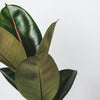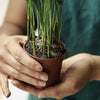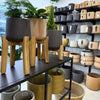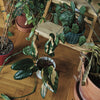Peat as a great aid in cultivation

Peat - everything you need to know about it!
Sphagnum moss (genus sphagnum) refers to types of moss that are found mainly in bogs, which is probably where they got their name from. There are many species of peat mosses, around thirty-two are found in the Czech Republic alone. Peat plants are specific and valued in the world of indoor plants and horticulture mainly for their ability to retain and gradually release water . Peat cells can hold a large amount of water, some species up to twenty times their dry weight. You can find more about peat moss and its possibilities of use later in the article.
As we mentioned earlier, sphagnum moss belongs to the very large species family of sphagnum mosses, which includes over 300 different species. The sphagnum is also interesting for its unending growth, it is able to constantly grow at the top, while the old leaves die from below. It is from the dead parts of the bog that peat is formed - for example, the Czech national nature reserve Rejvíz, known for its bogs and mossy lakes, is proud of it.
It's not a bog like a bog
In the world of indoor plants, sphagnum mosses are most often used. However, there are different ways of harvesting them, which subsequently affects their use, similarly to their different pH level (acidity - alkalinity level).
Dead peat moss is collected from the bottom of wetlands and bogs. This particular type of collection ensures that peat is mixed with other decayed parts of plants or insects, making it a very rich source of organic nutrients. Peat treated in this way is acidic. Dead sphagnum is therefore particularly suitable as an admixture in substrates.
Living sphagnum moss, as its name suggests, is collected from still living moss on the surface of swamps and wetlands. Either this particular species is used in its still living form or it is dried and further used in more special ways. Peat that has been processed in this way has a neutral pH (that is, neither acidic nor alkaline).
Peat from Give Me a Maid
Perhaps you have already managed to register that we also offer a living species of sphagnum in pressed form on our e-shop! This is a high-quality peat moss originally from Chile, which is processed into a cube by pressing and drying. Quality peat bogs last a long time, they can live for 2 to 5 years. Before use, this peat moss must be allowed to soak in water, then it "comes to life" and is ready for use.
Sustainability
Sphagnum moss, i.e. living peat moss, is also considered a more sustainable and environmentally friendly option than its dead counterpart (peat moss). It also requires aging to form before it is sufficiently developed and ready for harvest, while sphagnum moss is ready to be harvested and used within a few years.
Many uses of peat moss
Due to its specific absorption and other specific properties, sphagnum has many uses in gardening and growing houseplants.
Addition to the substrate
Dead peat moss (peat moss) is especially suitable for soil treatment both in gardens and in flower pots. Not only is this peat moss a source of organic nutrients, but we can still take advantage of its absorption capabilities as well as its lightness and breathability. Thanks to the peat, the necessary moisture is retained in the soil for longer. However, we have to keep in mind that this particular addition to their substrate will be especially appreciated by those houseplants that prefer a more acidic soil. Acidophilic plants include ferns and African violets. Peat in the soil is also evidence of palm trees, citrus, cacti and succulents, when it is contained in special substrates directly intended for the cultivation of these specific species.

Photo: Peat used for rooting Syngonium Albo Variegata cuttings
Medium for rooting and propagation
Living peat is an ideal medium for plant propagation - either in the form of tubers or cuttings. Thanks to its absorption capabilities, it maintains sufficient moisture, which is needed during the rooting of plants, and at the same time it is light and thus allows the roots to grow through without problems. Unlike hydroponics (use of water), peat moss is not too wet, so there is a lower probability of root rot when using it.
First aid for rotting
Peat has natural antibacterial properties. The moss contains the so-called sphagnol, which generally contributes to the disinfection of the soil , which is then less susceptible to the formation of molds and fungi.
Substrate alternative
Living peat moss is a suitable substrate candidate for most species of orchids (e.g. Phalaenopsis or Dendrobium) and other epiphytic plants that need moisture, but at the same time a sufficiently breathable substrate. We can also grow Tillandsia or Anthurium in the bog. Peat in its living form does not retain as many nutrients as ordinary soil, so if necessary, we can fertilize the plants grown in it.
Peat supports - poles
Live or dried peat is perfect for making supports for climbing and climbing plants , which can sink their aerial roots into the breathable and moisture-retaining peat. The peat stick is easy to make and either we can just wrap the peat around the stick with a string or we can win more with it. Various nets can be used (e.g. against the bite of animals), which can be found in hobby markets or even specially created skeletons and fillings made of hardened or recycled plastics.
We must not forget to check the peat support and add the necessary moisture.

Photo: Peat is a great tool for creating Kokedam
Cockade ladies
Peat is also popular in the creation of kokedam - the origin of Japanese hanging decorations made of moss, in which any moisture-loving houseplant can be grown. Peat can be easily shaped and thanks to this, peat kokedama is easier to create as well as to maintain and grow. As kokedamas, syngonia, spleenwort or marantha will make the biggest show.
The creative potential of peatland
Peat can be used in many of the ways mentioned earlier, but this does not mean that this is an exhaustive list. Do you have a garden? Yes? And do you have your own bog? The peat bog encourages creativity in various ways, and if we would like our smaller Rejvíz at home in the garden, no problem! We can also add a few more hardy carnivores as decoration.
Decoration
Peat is not only practical, but can also be decorative. It can make the final look of a transparent flower pot or terrarium special, where we can use it to fill an otherwise "dead" space.
Furthermore, it is possible to use peat moss in a similar way as in the production of supports and poles, but we can make a "living wreath" out of it with the addition of flowers.
In conclusion - Watch out for mold!
Although we mentioned the antibacterial effects of sphagnum mosses earlier, even these mosses are not completely immune to some fungi. Of course, they are more resistant and persistent, but unfortunately even peat mosses sometimes succumb. Due to its absorption capabilities, peat moss is not only a perfect medium for plants, but also for fungi.
If by chance a white coating indicating mold appears on the peat, try not to wet the peat for a while and let it dry. If even drying out the sphagnum does not help, we can use products that are specially designed to fight fungi (e.g. sprays).
Mold can be prevented thanks to thorough prevention. If we use stagnant water, we will reduce both the occurrence of mold and white coatings, as well as the deposition of scale and chlorine.
In most cases, however, these are not fungi that could harm the plants. Rather, it is a decorative problem, as white coatings, for example, on peat sticks do not look the best and do not give a healthy impression. Therefore, it is neither desirable nor necessary to panic in most cases.
"The peat moss is really a great helper for me. After I tried it for the first time, I season most of my maids in it. First of all, I let the more rare and close to my heart plants season in it, which season faster in peat than in ordinary water and are not so susceptible to rot. That's my certainty!”
Author: Jana Beránková
-
Posted in
Zajímavosti a tipy




